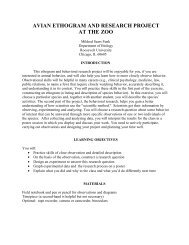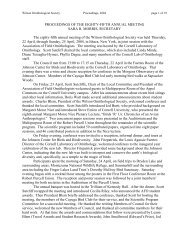Available now - Wilson Ornithological Society
Available now - Wilson Ornithological Society
Available now - Wilson Ornithological Society
Create successful ePaper yourself
Turn your PDF publications into a flip-book with our unique Google optimized e-Paper software.
WOS 2010 ~ ABSTRACTS p. 14<br />
ABSTRACTS – CONTRIBUTED ORAL PRESENTATIONS<br />
Arranged by presentation number. Presenting author is indicated by bold type. Contributions eligible for student<br />
presentation awards are indicated by superscript “S” at the start of the title.<br />
01 Short-chain carboxylic acids from Gray Catbirds (Dumetella carolinensis) uropygial secretions vary with<br />
testosterone levels and photoperiod. Rebecca J. Whelan and Tera C. Levin, Depts. Chemistry and Biochemistry,<br />
Oberlin College, Oberlin OH 44074, Jennifer C. Owen, Dept. Fisheries and Wildlife, Michigan State Univ., East<br />
Lansing, MI 48824, and Mary C. Garvin, Dept. Biology, Oberlin College, Oberlin OH 44074<br />
The uropygial gland of birds produces secretions that are important in maintaining the health and structural integrity<br />
of feathers. Non-volatile components of uropygial secretions are believed to serve a number of functions including<br />
waterproofing and conditioning the feathers. Volatile components have been characterized in fewer species, but are<br />
particularly interesting because of their potential importance in olfactory interactions within and across species. We<br />
used solid-phase microextraction headspace sampling with gas chromatography-mass spectrometry to detect and<br />
identify volatiles in uropygial secretions of Gray Catbirds (Dumetella carolinensis), a North American migratory<br />
bird. We consistently detected the following carboxylic acids: acetic, propanoic, 2-methylpropanoic, butanoic, and<br />
3-methylbutanoic. We tested for the effect of lengthened photoperiod and/or exogenous testosterone on volatile<br />
signal strength and found a negative effect of lengthened photoperiod on the signal strength of propanoic, 2-<br />
methylpropanoic, and butanoic acids, suggesting a trade-off between their production and heightened night-time<br />
activity associated with lengthened photoperiod. Signal strength of propanoic and 2-methylpropanoic acids was<br />
lower in birds treated with exogenous testosterone than in birds treated with placebos. Sex did not affect signal<br />
strength of any of the volatile compounds.<br />
02 S Breeding Biology of five species of High elevation Andean Tanagers. Gustavo Adolfo Londoño, Univ. Florida,<br />
Dept. Biology, and Florida Museum of Natural History, Gainesville, FL 32611<br />
The tanagers are a Neotropical group of birds that has the highest number of species in the highlands of South<br />
America. There have been a few phylogenetic and behavioral studies conducted on this group, but there is a paucity<br />
of information on breeding biology. This is especially true for highland species. Thus, my objective was to describe<br />
new nest, building, incubation and feeding behaviors for five species of highland tanagers in the Peruvian Andes.<br />
Between 2007 and 2009 I found and monitored more than 30 nest of Scarlet-bellied mountain-tanager (Anisognathus<br />
igniventris*), Blue-capped tanager (Thraupis cyanocephala), Grass-green tanager (Chlorosnis rieferii), Hooded<br />
mountain-tanager (Buthraupis montana*) and Golden-collared tanager (Iridosornis jelskii*). While I have<br />
documented the breeding behavior for the first time for all of these species, three of these nests are also still<br />
undescribed*. All of these high elevation mountain tanagers have a clutch size of one egg, which is not common<br />
among tropical bird species. The egg mass and size varied across species, A. igniventris (25.6 x 18.4 mm , 4.55 g;<br />
n=18), T. cyanocephala ( 27.1 x 18.1 mm, 4.7 g; n=19), C. rieferii (28.8 x 21.5 mm, 7.1g; n=2), B. montana (32.9 x<br />
22.8 mm, 9.3 g; n=5) and I. jelskii (23.5 x 16.5 mm, 3.9g; n=4). Egg coloration and nest location varied among<br />
species, however, nest shape and some nest materials are similar. Most nesting traits shared among these species<br />
support new relationships suggested in recent studies. Nesting behavior (time on the nest, number and length of<br />
trips), feeding behavior, and egg temperatures varied among species.<br />
03 S Nest success of S<strong>now</strong>y Plovers in the Southern High Plains of Texas. Sarah T. Saalfeld and Warren C.<br />
Conway, Arthur Temple College of Forestry and Agriculture, Stephen F. Austin State Univ., Nacogdoches, TX<br />
75962, David A. Haukos, U.S. Fish and Wildlife Service and Dept. Range, Wildlife, and Fisheries, Texas Tech<br />
Univ., Lubbock, TX 79409, and William P. Johnson, Texas Parks and Wildlife Dept., Canyon TX 79015<br />
S<strong>now</strong>y Plovers (Charadrius alexandrinus) have experienced population declines throughout their range. Decreased<br />
nest success has been recognized as a primary cause for the decline of the Western S<strong>now</strong>y Plover. Although<br />
populations west of the Rocky Mountains have been extensively studied, few studies have focused on interior<br />
populations. We estimated nest success of Western S<strong>now</strong>y Plovers on 3 saline lakes on the Southern High Plains of<br />
Texas during 2008 and 2009 and determined causes of nest failures and factors influencing nest success. We<br />
monitored 215 nests and Mayfield estimates of nest success ranged from 7 – 32% (mean = 22%) with leading causes<br />
of failure being predation (40%) and weather (36%). Nest success was influenced by location, as well as negatively<br />
influenced by number of plants within 707cm2 of nest, percentage of dry substrate within lake, and time during<br />
nesting season. When compared to 10 years prior (i.e., 1998 – 1999), mean nest success within this region declined<br />
by 31%, with greater percentage of failures due to predation. Although nest success was variable from year to year,<br />
our results suggest that if nesting S<strong>now</strong>y Plovers continue to experience increased predation rates, decreased<br />
hydrological integrity, and habitat alterations, populations may decline or continue to decline throughout this region.<br />
Because surface water availability is one of the key components for nesting and nest success, it remains important to<br />
conserve the entire complex of wetlands within the Southern High Plains of Texas including freshwater springs<br />
discharging into saline lakes, the Ogallala aquifer, and playa wetlands.





